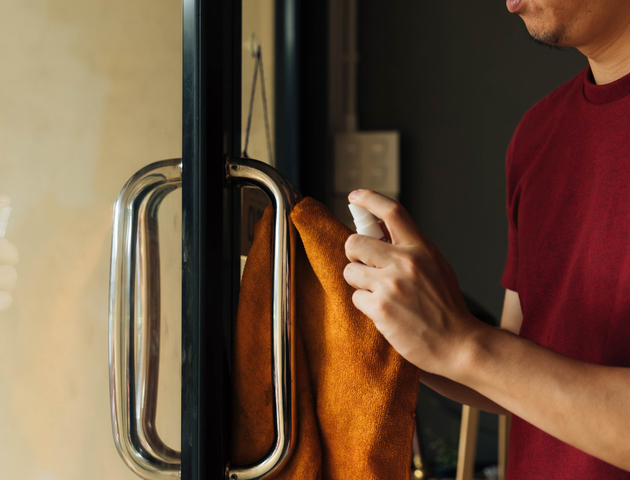
What are respiratory infections?
The human respiratory system comprises the upper and the lower respiratory tract. The upper respiratory tract includes nose, sinuses, throat while the lower respiratory tract includes airways and lungs.
Respiratory infections mainly occur due to bacteria or viruses. Infections that occur in the upper respiratory tract are the common cold, cough, mild flu, sinus infection, and tonsillitis. Infections that occur in the lower respiratory tract are pneumonia, bronchitis, and tuberculosis.
How do respiratory infections spread from surfaces?
Respiratory infections spread through frequently touched surfaces. This mode of transmission of infection is called indirect contact transmission and the surfaces are known as fomites.
Fomites refer to commonly touched surfaces that can carry and spread the disease. Respiratory infections spread when you touch surfaces contaminated with bacteria or viruses and then touch your eyes, nose, or mouth before washing your hands. Some of the surfaces that are frequently touched and maybe a source of infection include handles, doorknobs, lift buttons, desks, chairs, keyboards, mouse, phones, lock and keys, toilets, taps, sinks staircase railings, etc.
Common viruses and their survival time on various surfaces:
1. Influenza A virus: These can survive for 24–48 hours on a non-porous surface (metal, glass, plastic) and up to 8–12 hours on porous surfaces (paper, wood, cardboard).
2. Human rhinoviruses: The survival times of infective virus and viral RNA have been reported as > 24 hours and > 48 hours.
3. Coronavirus: Survival times for coronavirus on surfaces can greatly vary. One study showed the survival time of SARS was limited & could not be recovered from certain surfaces. However, some other studies indicate survival times for SARS and Middle East respiratory syndrome coronavirus (MERS-CoV) to be much longer, depending on the type of surface. SARS-COV-2 virus is known to survive on plastic & stainless steel for 72 hours, cardboard for 24 hours, and copper for 4 hours.
Now, let’s have a look at some of the important precautions to be taken to prevent the spread of respiratory infections from frequently touched surfaces.
Steps to prevent indirect transmission:
1. Cleaning: This refers to the removal of any kind of impurities, dirt, and germs from surfaces by simply using water and soap. It does not kill germs, but by lowering their number to a certain extent, it reduces the risk of spreading infection.
2. Disinfecting: This refers to the killing of germs on the surfaces not visible to the naked eye by using certain chemicals (EPA-approved disinfectants). This process might not clean dirty surfaces but by killing germs it reduces the risk of infection.
3. Sanitizing: This process lowers the number of germs to a safe level, as declared by public health standards. Usually, sanitization is done in places like kitchens and other areas that come in close contact with food. You may also sanitize frequently touched surfaces like doorknobs, handles, etc. or toys that your baby plays with.
Bottom line
Respiratory infections are caused by bacteria and viruses around us. Thus, it is important to understand its mode of transmission and take necessary precautions in order to protect yourself and help prevent the spread of illnesses.
Stay safe, stay healthy!
Disclaimer: This initiative, which is bought to you by 1mg Technologies Pvt. Ltd. (“1mg”) and Lizol, a trademark owned by Reckitt Benckiser Inc (“RB”) is for public awareness only. This should not be considered to be a medical advice and/or a substitute to a physician’s advice. The views and opinions expressed by the participating physicians are their independent professional judgement in collaboration with 1mg. RB does not claim any responsibility for the accuracy of their views. Please ensure that you consult your physician for further clarity.
References
1. Chronic Respiratory Infections. National Jewish Health. https://www.nationaljewish.org/conditions/chronic-respiratory-
infections#:~:text=Respiratory%20infections%20are%20infections%20that,time%20indoors%20
and%20in%20groups.
2. Brenda L. Tesini. Overview of Viral Respiratory Infections. MSD MANUAL
Professional Version. https://www.msdmanuals.com/professional/infectious-diseases/respiratory-viruses/overview-of-viral-respiratory-infections
3. Stephanie A. Boone and Charles P. Gerba. Significance of Fomites in the Spread of Respiratory and Enteric Viral Disease. Appl Environ Microbiol. 2007 Mar; 73(6): 1687–1696. https://aem.asm.org/content/73/6/1687
4. P. Vasickova, I. Pavlik, Pieter L Fraaij, et al. Issues Concerning Survival of Viruses on Surfaces. Food Environ Virol. 2010; 2(1): 24–34. https://www.ncbi.nlm.nih.gov/pmc/articles/PMC7091010/
5. Cleaning And Disinfecting Your Home. Centers for Disease Control and Prevention. https://www.cdc.gov/coronavirus/2019-ncov/prevent-getting-sick/disinfecting-your-home.html
6. Stephanie A. Boone and Charles P. Gerba. Significance of Fomites in the Spread of Respiratory and Enteric Viral Disease. Appl Environ Microbiol. 2007 Mar; 73(6): 1687–1696. https://www.ncbi.nlm.nih.gov/pmc/articles/PMC1828811/
7. Jasmin S Kutter, Monique I Spronken, et al. Transmission routes of respiratory viruses among humans. Current Opinion in Virology, Volume 28, February 2018, Pages 142-151
https://www.sciencedirect.com/science/article/pii/S1879625717301773
8. Neeltje van Doremalen, Trenton Bushmaker, Dylan H. Morris, et al. Aerosol and Surface Stability of SARS-CoV-2 as Compared with SARS-CoV-1. N Engl J Med 2020; 382:1564-1567. https://www.nejm.org/doi/full/10.1056/NEJMc2004973
9. Cleaning and Disinfection for Households. Centers for Disease Control and Prevention. https://www.cdc.gov/coronavirus/2019-ncov/prevent-getting-sick/cleaning-disinfection.html